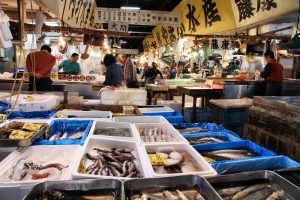The operator of the devastated Fukushima Daiichi Nuclear Power Plant, TEPCO, has begun its second release of treated radioactive wastewater into the Pacific Ocean, despite seafood exports plummeting from Beijing’s retaliatory ban on Japanese marine products.
China is a fierce critic of Japan’s discharge plan. It has maintained the release of contaminated water is a major cross-border nuclear safety issue. The Chinese Foreign Ministry says the Japanese government has “not proved the legitimacy of the decision to discharge the water into the sea.” China’s government has said it would take necessary measures to protect the marine environment, food safety, and public health.
Immediately after the wastewater release began on August 24, China instituted a ban on all seafood imports from Japan, saying it had “the right and the responsibility to take legitimate, reasonable and necessary preventative measures to protect marine environment, food safety and people’s health.” Russia has also announced restrictions on Japanese seafood in lockstep with China, as a “precautionary measure.”
China and Hong Kong are the largest importers of Japanese seafood and agricultural products. Together, they account for 40 percent of Japan’s total seafood exports. In August, seafood sales to China fell 76 percent – a loss of approximately $14 million compared to the previous month.
China’s embargo of Japanese seafood is wreaking havoc on Japan’s fishing industry. In the almost two months since the ban, it is struggling with oversupply and declining value.
The import ban is causing mounting financial stress for the scallop sector. Scallops are the most high value seafood, heavily dependent on the Chinese market. Within Japan, 80 percent of scallops are sourced by Hokkaido prefecture, followed by Toshima prefecture. The prices for scallops fell 11 to 27 percent across three prefectures since China imposed the ban.
Governor of Hokkaido Suzuki Naomichi said China’s response was “unjust” and not based on scientific evidence.
In Fukuoka and Nagasaki, the price of red fish, which is considered auspicious in China, has also fallen drastically. While the fish has been rerouted locally, the price per kilogram fell to 1,400 yen ($10) from 1,700 yen.
Prime Minister Kishida Fumio has vowed to protect the fishing industry at all costs. The government announced emergency rescue measures valued at $140 million. It aims to temporarily purchase and store scallops and other seafood and develop new sales routes to Europe in lieu of exports to China.
Kishida said the emergency fund was in addition to the $547 million allocated to fisheries and seafood processing businesses to combat reputational damage. TEPCO has also begun a compensation scheme for some 1,000 affected fishermen.
Japan says it will continue to pressure China to lift its seafood import ban via diplomatic channels. Kishida has urged China to “act on scientific grounds and to disseminate accurate information,” saying the comprehensive report by the International Atomic Energy Agency (IAEA) was “widely accepted by the international community.” The government is also considering submitting a complaint to the World Trade Organization.
U.S. Ambassador to Japan Rahm Emanuel accused China of “economic coercion” in imposing the seafood ban.
Even beyond China’s import ban, the Japanese fishing community has major concerns about the reputational damage to the industry from the continued discharge of treated wastewater from the Fukushima Daiichi Nuclear Power Plant. The government and TEPCO are ramping up an international public awareness campaign based on the scientific safety of the water release plan.
TEPCO says that since the first release on August 24, daily checks of tritium concentrations in seawater around the facility have been below international and domestic safety standards. They say the concentration of tritium in one liter of seawater ranges from 63 to 87 becquerels, well below the government standard of 1,500 becquerels. During the first discharge of some 8,000 metric tons of wastewater, TEPCO announced that daily inspections of equipment and facilities showed no abnormalities. The Ministry of Environment, Nuclear Regulation Authority, Fukushima Prefecture, and Fisheries Agency are also conducting regular seawater and fish testing that are published online.
The IAEA also announced that experts from the agency, China, South Korea, and Canada will visit Japan to take seawater, seabed sediment, soil, and fish samples around the site for independent environmental monitoring. The results will be compared to last year’s samples of seawater radionuclides.
TEPCO plans to release 2.3 percent of the total amount of treated water currently stored in 1,000 tanks on site by the end of fiscal year 2023. The entire release is estimated to take 30 to 40 years to complete.

































